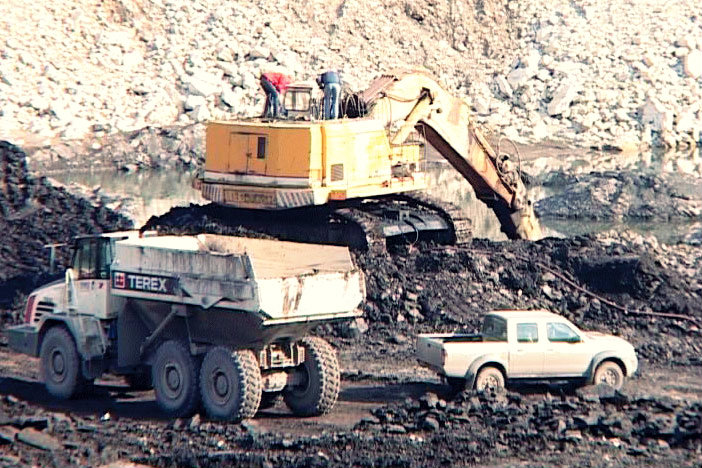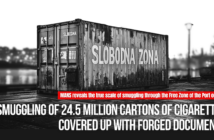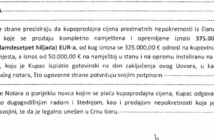 MANS Investigation Center indicates that that Rudnik uglja (coal mine) from Pljevlja is trying to avoid the obligation to invest in the rehabilitations of exhausted mined lands
MANS Investigation Center indicates that that Rudnik uglja (coal mine) from Pljevlja is trying to avoid the obligation to invest in the rehabilitations of exhausted mined lands
According to the official data available to MANS Investigation Centre and concerning mining ore from the mine sites Potrlica and Cementara during a five-year period, Rudnik uglja from Pljevlja is obliged to invest €8.8 million in the rehabilitation of land. Yet, it is trying to avoid the legal obligation, although the revenues earned from sale of coal from these mines, within the given period, were over €237 million.
In the Environmental Impact Assessment Study on coal mining in the pit Potrlica and one part of the pit Cementara, which covers the period between 2010 and 2014, Rudnik uglja showed that it would extract 7.6 million tons of coal, while average rehabilitation costs were estimated at €1.17 per ton of coal, resulting in overall costs for the five-year period of approximately €8.9 million.
However, the data which MANS Investigation Centre acquired from the Ministry of Economy show that Rudnik uglja extracted somewhat less coal from 2010 to 2014, around 7.5 million tones, so it is obliged to pay around €8.8 million for the rehabilitation costs.
Within the same period, the company earned over €237 million from the sale of coal from Potrlica and Cementara, which is confirmed in the financial documents, and is now trying to avoid the obligation regarding the land rehabilitation with the support of the national electric enterprise Elektoprivreda AD Niksic (EPCG), which would open a new ash and slag landfill, following the same prescription as the one from 2009.
Namely, Rudnik uglja avoided the obligation of mine rehabilitation regarding the site Sumane, where the ore was extracted at the time, by selling it to EPCG, which would turn it into a new ash and slag landfill. The landfill would be built after the existing landfill Maljevac reached the maximum limit of waste.
The value of the contract of sale of the mine in Sumani was €7.5 million and it was the part of the total package of receivables of the two companies which was worth €40 million. The Government of Montenegro renounced its claims at the expense of the state budget, on the eve of the Italian company’s A2A entering in EPCG and Rudnik uglja,.
Meanwhile, EPCG build up the landfill Maljevac planning to dispose waste there until 2020 and giving up the idea of building a new disposal site in Sumani. This means that the damage from the purchase of the land which will not be used by EPCG was €7.5 million, so this case unquestionably needs to be addressed by the competent Public Prosecution Office as well.
Following the same pattern as with the site Sumane, the construction of a new landfill at the site Potrlica has been announced. According to this, the mining company would free itself from the obligation to invest millions in rehabilitation of the land devastated by mining operations. At the same time, it is not known whether EPCG will purchase the land at the mine Potrlica and at what price, but it would undoubtedly be squared through citizens’ electricity bills.
Moreover, if such a scenario came true, it would mean not only ignoring the will of the citizens of Pljevlja, who were not asked for the opinion about the construction of a new hazardous landfill only a few kilometers away from the urban area, but it would also be confirmed one more time that the two companies operate contrary to legal obligations, and almost as a “state within a state”.
A majority shareholder in EPCG is the State of Montenegro, whereas the Italian company A2A is the second largest shareholder. Concerning Rudnik uglja, the largest shareholder is A2A, followed by the State of Montenegro, while the third biggest shareholder is the Prime Minister’s brother Aco Djukanovic. Since 2009, when A2A arrived in Montenegro, Aco Djukanovic has been the one who profited from it most due to the fact that the Italian company kept dozens of millions in his bank, ensuring its liquidity and survival.
Ines Mrdovic
This text is created with the support of the European Union within the project “Zero Tolerance to Corruption”. Network for Affirmation of Non-Governmental Sector – MANS is solely responsible for the contents of this article, and the views taken herein shall not in any case be considered as those of the European Union.
Rehabilitation costs cut abruptly
It is very interesting the fact that Rudnik uglja abruptly cut land rehabilitation costs concerning the continuation of coal mining in the pits Potrlica and the area of Cementara.
According to the recent Environmental Impact Assessment Study on coal mining in the pit Potrlica and in the area of the pit Cementara, which covers the period between 2015 and 2019, the Pljevlja-based company plans to extract around 9 tons of coal, i.e. 1.8 million tons annually.
Having in mind the average selling price of coal charged by Rudnik uglja in recent years, it is clear that the company made additional profit of €230 to 240 million at the time, whereas, on the other hand, the rehabilitation costs were projected at the absurd sum of €334 thousand.
If Rudnik uglja took into consideration the cost of rehabilitation based on 2010 model, it is obvious that the exploitation of nine million tons would cost it €10.5 million.
With regard to the fact that the company from Pljevlja has huge financial problems and the Government insists on building a new thermal power plant in Pljevlja at any costs, it is probable that this is one of the ways to reduce overall costs of the investment, for which MANS Investigation Centre pointed out on a number of occasions that it is economically inefficient and it would do more harm than good.
State shows tolerance towards the mining company
The planning documents on the thermal power plant in Pljevlja, which was the subject of a public discussion in May 2015, indicate that investments in rehabilitation of the exhausted coal mines have been negligible in the recent years, so in this sense it states that only 10 percent of the devastated land has been rehabilitated.
The Mining Law clearly defines that mineral resources are of common interest, owned by the state and that they may be exploited under the conditions and methods determined by law.
During and after completion of works on the exploitation of mineral resources, and not later than one year after completion of the works, the concessionaire is obliged to restore the mined land in accordance with the land reclamation project.



